There I was sitting in one of the few two-channel demo rooms at CanJam Orange County last March listening to the incredible ENIGMAcoustics M1 speakers with their world class Sopranino super tweeter ($15k/pair USD with stands) and I was loving the sound. Powering the amazing M1’s were a pair of 200-watt Class-D monoblock amps from Questyle Audio Engineering, the firm Bruce Ball represents here in the states. When I had walked into the demo room I had not noticed where the source of the amazing sound I was hearing was coming from. Bruce asked me to come to the back of the room and there was a small iPhone-sized device hooked to another small box. What is that? Bruce responded, that is the new QP1R Digital Audio Player (DAP) and the digital wireless 5GHz preamplifier. Two things at first got my attention; first, Wireless? Yes, the preamp was digital and wireless to the Class-D Monoblocks. Second the quality of what I was hearing had no business being sourced from this little device as it sounded spectacular. Clearly Questyle was making some major moves in the Hi-res scene! Bruce had my attention.
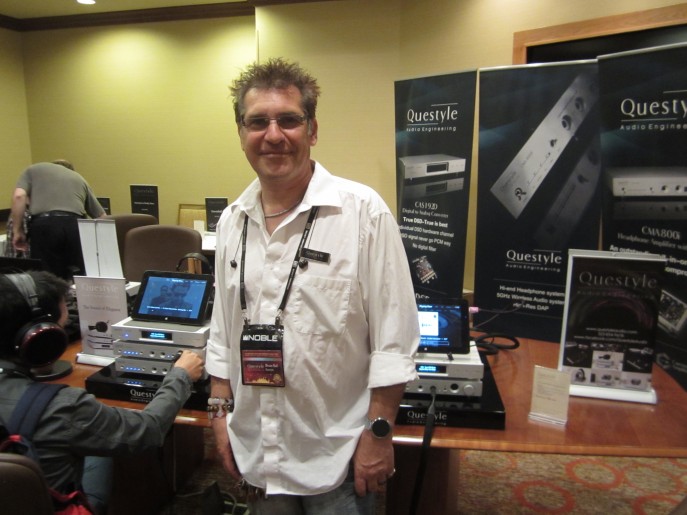
I asked Bruce about the QP1R. He explained it was a pre-release unit that had been under development for three years. They hoped to have it available by the end of 2015. Questyle was offering two models. The QP1 and the QP1R (R for Reference) priced at $599 and $899 respectively. I asked Bruce to sign me up for a review unit .
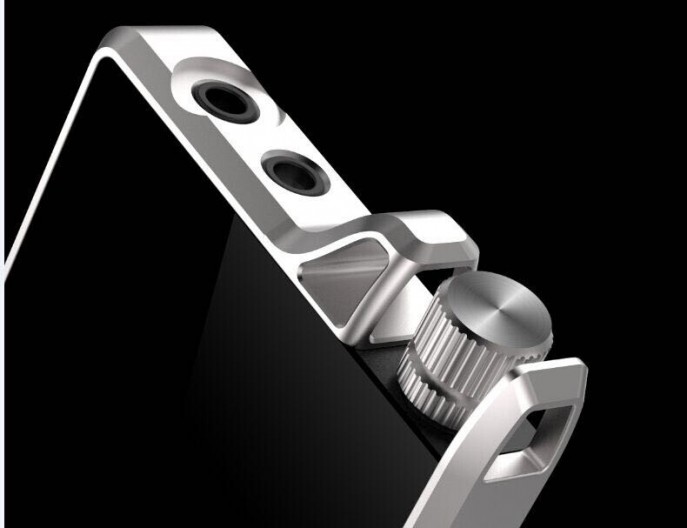
A few months later FedEx arrived with a shiny new Space Gray QP1R. Right out of the box the QP1R had the look of an aspirational piece of gear. The weight of the unit felt solid and and build quality was outstanding. The Foxconn assembled combination of machined aluminum and Gorilla Glass had a well-finished look. It strikes you as high end and yet it retails for under a grand! The competitors have bringing out new DAP’s for several thousand dollars these days so finding something for three digit pricing is a great way start to a review! The Space Gray color worked for me. Fashionista’s can opt for the gold model. Either color is visually striking.
The QP1R is Questyle top of the line reference model. The extra $300 over the lower priced model get you upgraded parts plus 32Gb of in storage vs. the 16Gb on the QP1. Both units have slots for two Micro SD memory cards. The specs say 128Gb per card for a max on board of 288Gb. However, early adopters on the Head-Fi.org QP1 forum have found the unit is perfectly happy with the new SanDisk 200Gb cards. 432Gb of portable audio anyone?
The QP1R supports all of the necessary file types as well as the high resolution available in both PCM and DSD files. Specifically according to their literature the unit can play ALAC, APE, FLAC, AIFF, WAV, WMA Lossless up to 24bit/192kHz and high-Res audio files such as DSD64 and DSD128 and of course, mp3. This covered all the file types I had in my collection of over 25,000+ digital songs so that was a good thing. I had no trouble placing a random collection of file types and formats on the SD cards. The unit sorted them all quickly and I could play them in any combination without incident. One caveat, there appears at the moment to be a 5800 song limit to the firmware. Questyle is working on this and expect a fix with new firmware fix shortly. Currently a new firmware file must be downloaded and copied to the Micro SD card via PC. Something about the Mac’s configuration does not work with this simple file copy. I could not get an update with a Mac downloaded and transferred file. Using a PC the download and copy to the card the firmware update was quick and seamless.
Firmware updates are done by loading the new firmware file to the small Micro SD card and placing it in slot one (The left one!) and then accessing the settings on the unit. Scrolling to update and follow the simple prompts it took all of 20 seconds to complete the update. When the unit is plugged into a computer the QP1R screen will show a USB symbol to let you know you are connected properly. You can use this connection to drag and drop music files to any of the three storage areas. Very simple and handy! Large Micro SD cards will likely prompt you to invest in a USB 3.0 card reader. It took a couple of hours to load my 64Gb cards when directly connecting the QP1R to a Mac or a PC. Still it is simpler than the Android file transfer required by other devices.

One design choice made by Questyle that greatly appeals to my old school tastes is the click wheel navigation. Any fans of the venerable iPod Classic will be right at home navigating the Questyle twins. I have found with time the wheel loosens up. It was a bit stiff out of the box. Much more information can be found on the Questyle web site. http://www.questyleaudio.com/product-qp1
Questyle has been manufacturing very high quality headphone amps such as the CMA800R reviewed on Headphone.Guru for a few years now. One of the design goals was to incorporate the innovations they have made for their desktop gear and transfer those qualities to a portable unit. A lofty goal to be sure! This would include their superlative current mode Class-A amplification paired with a very low output impedance of only 0.19 Ohms! Using a three level gain design this allows for dead quiet operation with sensitive In Ear Monitors (Low gain up to 36 Ohm headphones) to full sized higher impedance headphones (High gain over 36 Ohms and up) with enough power to properly drive them all with an average of nine to ten hours of battery life via its 3300Mah battery. This means you, Planar Magnetics! It was time to see if they had achieved these goals.
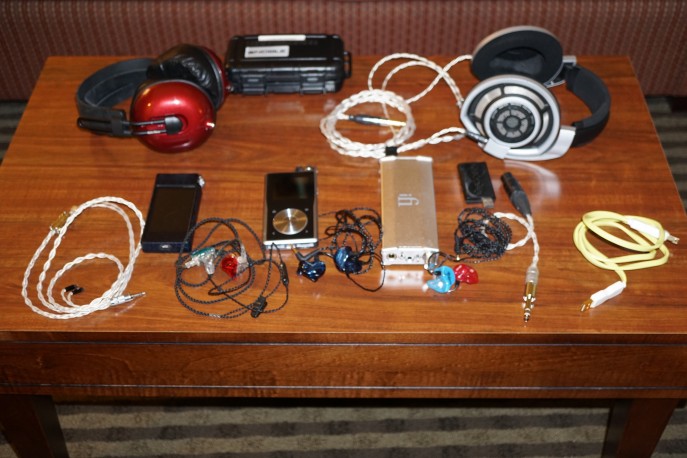
Once I had the unit set up, files transferred to the Micro SD cards and firmware updated it was time to listen. I brought out several headphones and other portable DAP’s, amps and DAC’s to assist with the comparison’s.
None of my primary headphones are particularly difficult to drive. Even the MrSpeakers Alpha Prime closed Planar Magnetics were driven easily by the QP1R via high gain. I had a wide selection of Open, Semi-Open, Closed, Circumaural (over ear) and Supraaural (on Ear) and CIEM (Custom In Ear Monitors) ranging in price from $279 to $1699. Comparable electronics ran from $299 to $1799. There is not enough room here to go into detail on every combination. I will comment on the highlights of the review listening sessions.
First up I paired the QP1R in low gain with my Ultimate Ears UE11 Pro CIEM’s (Review forthcoming on Headphone.guru) The UE11’s buck the current trend of the number of drivers war by staying with a traditional Low/Mid/High three Balanced armature design. These babies’ bring the bass too. I love them for travel. The 3D printed shells fit perfectly and seal out the noise. Consequently, they are very sensitive to background hiss. None here! The QP1R and the UE11’s really got along great.
I put on The Counting Crows Sullivan Street from August and Everything After (AIFF 24/192 HD Tracks). The fall colors are coming on strong here and this is a perfect song for the season. The QP1R presented a wonderful blend of guitar, piano and drums backed by a firm bass line. Vocals were well defined with the right timbre and character I would expect from this well recorded album. Playing the same track with the Astell & Kern AK120mkII also presented a solid performance. The AK 120 MK11 uses the same Cirrus Logic CS4398 DAC chip. It comes in at nearly twice the price as the QP1R. Its presentation was a bit leaner; perhaps a bit more clinical. Given the same DAC I had to chalk this up to the amps. The Questyle brings full Class-A to the table. This tends to bring more body from my past listening experience. Both were excellent presentations. However, if I had to choose I would pick the QP1R as my favorite of these two for this song.
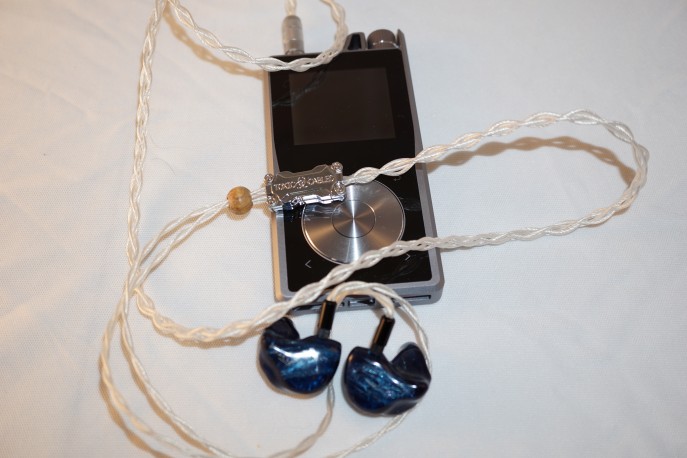
Next up I went to Alice Cooper’s Greatest Hits and put on Elected. (AIFF 24/192 HD Tracks) This song is recorded to simulate a political candidate in a hall making an election speech. The spaciousness is one of the interesting parts of the recording. The QP1R recreated that sense of wide space when paired with the Noble Audio K10 CIEM’s. Once again, I was using Low Gain with sensitive IEM’s. I got all of the crunch I expected from the electric guitars and Alice’s growling voice was crisp and clear. Switching to the LH Labs Geek Out V2 Infinity I experienced another very high quality presentation. The V2 infinity is also full Class-A with 3 levels of gain. I also used it on the 450mA low gain setting. The V2 uses the new ESS AQ2M Sabre chip and here you have a difference in style of presentation. The new Sabre pulls the notes apart just a bit more and allows more detail through the music. On the other hand the QP1R has an organic completeness that is very pleasing. In the end, I did not choose a clear winner for sound. The Geek V2 is a USB Amp/DAC that you plug into a laptop to source the music. So I had a $1500 MacBook Retina holding my music files. The QP1R was completely portable. No contest then for portability. I get the sound without the backpack full of gear to transport my files.
Switching to the AudioQuest NightHawk (Review forthcoming on Headphone.guru) I served up Alan Parsons Project’s I Robot and went through the first half of the album. (DSD64 Superhires.com) I love the NightHawk’s. They don’t sound like any other headphone. They get close (By design) to that Speaker sound” on your head. The QP1R paired beautifully with them. The sense of air and space with the chimes and the back and forth of the harpsichord provided a similar experience to listening to the Vandersteen’s. Clearly it was a more intimate presentation, yet when I moved the QP1R into the mix with the Cary Audio SLI-80 and sourced from the QP1R via its line out through the Cary and the 2CE Sig II’s it was not far removed of a presentation. Assuming you left the cables handy you could use the QP1R as your digital transport and it would do yeoman’s work with a solid two-channel system. As for the NightHawk’s, they found a new best friend in the QP1R. I brought the QP1R over to a friend who owns a high-end store. He sells the NightHawk’s along with Audio Research and Vandersteen. We compared the QP1R with the AK120mkII and his own AK Jr. He now has a QP1R on order. We agreed it was a Class-A thing. We listened for a couple of hours and in the end we kept coming back to that. He is a huge NightHawk fan and the pairing just hit him the right way. He stopped comparing and simply began listening to music. That IS the point, right?
Finally I pulled out the Audeze LCD-X’s. The highly regarded LCD-X is a top end Planar Magnetic headphone. While Planar’s have a well-deserved reputation for being power hungry, the X’s are not particularly hard to drive. The LCD-X’s 20-Ohm impedance a combined with an efficient 103db make it a easy load to drive. They presented no challenge for the QP1R in High Gain. The terrific sub Bass that the LCD line is noted for was delivered in spades as I continued with the Alan Parsons album. The incredible bass line of Don’t Let it Show flows though the entire song and the LCD-X’s brought it out to play. It was hard to believe I was using a portable DAP to deliver the goods here. I have enjoyed this album since 1977 and this was a good a presentation as I have heard. It was a thoroughly wonderful experience.
The Questyle Audio Engineering QP1R proved to be a Jack-of-All-Trades and a Master of All! Every headphone I used performed brilliantly. It served at a high level in a two-channel system and unlike the a excellent Geek Out V2 Infinity, I did not have to carry the laptop along for the ride. I had more room at Panera for the morning repast.
Highly recommended!
PROS
Fantastic build quality
Plenty of gorgeous Class-A power
Very high capacity due to two card slots
Competitive battery life
Best in class sonic price/performance
Can be used as a two channel home source and DAC
CONS
A few firmware issues to resolve
Not completely Mac compatible
Click wheel takes some time to break in
Associated Equipment Portable
Astell & Kern AK120mkII http://www.astellnkern.com/
LH Labs Geek Out V2 Infinity www.lhlabs.com
Ifi Micro iDSD http://ifi-audio.com/portfolio-view/micro-idsd/
Fostex HP-P1 http://www.fostexinternational.com/docs/products/HP-P1.shtml
iPod Classic 5th gen www.apple.com
Toxic Cables http://toxic-cables.co.uk/
Light Harmonic Lightspeed 1G USB cable www.lightharmonic.com
Audeze LCD-X www.audeze.com
Sennheiser HD800 www.sennheiser.com
MrSpeakers Alpha Prime www.MrSpeakers.com
AudioQuest NightHawk www.audioquest.com
Beyer Dynamic DT1350 http://north-america.beyerdynamic.com/shop/dt-1350.html
JH Audio JH16 FP www.jhaudio.com
Ultimate Ears UE11 Pro www.ultimateears.com
Noble Audio K10 www.nobleaudio.com
Associated Equipment two-channel
Cary SLI-80 Ultimate Mod Integrated Amplifier www.caryaudio.com
Vandersteen 2CE Signature II www.vandersteen.com
Specifications*
QP1: standard version
QP1R: reference version
As a Reference piece, the QP1R uses higher quality components, as well as, a more critical approach to the audio circuit, producing lower distortion (QP1R THD+N=0.0006%, QP1 THD+N=0.0015%) and superior sound quality.
The QP1R also employs a different PCBA, a larger internal storage chip (32GB), and a different version of software.
Patented Current Mode Amplification in headphone AMP, all discrete components, Pure Class-A circuit.
File Format Support: WAV, FLAC, ALAC, APE, AIFF, ADPCM, LPCM, MP3, WMA, WMA Lossless, OGG, AAC, DFF. DSF
Sample Rates: PCM Native 44.1 – 192 KHz (16 bit/24 bit) DSD Native: DSD64 (1 bit 2.8Mhz)/DSD128 (1 bit 5.6Mhz)
DAC: Cirrus Logic CS4398
Outputs: 3.5MM Headphone output, 3.5MM Line out and Optical output
Frequency Response: 20Hz – 20kHz (+/- 0.1dB)
QP1 THD +N= 0.0015%
QP1R THD+N=0.0006%
Output Impedance: QP1: 0.19 Ohm | QP1R: 0.15 Ohm
Memory: Internal QP1 16 Gb | QP1R 32Gb
External Two 128Gb Micro SD slots
Battery 3300Mah Li-Polymer 8-10 hour
Charge Current: Via PC USB @ 450 mA approx. 8 hours
Via Charger @ 2A approx. 4 hours
Body: CNC cutting aluminum case – Space Gray or Gold
Headphone Amp output power:
Gain = High
Max Output Amplitude: Vout=1.9V rms
Output Power: Pout=40mW @32Ω
Pout=12mW @300Ω
Gain=Middle
Max Output Amplitude: Vout=1V rms
Output Power: Pout=31mW @32Ω
Pout=3.5mW @300Ω
Gain=Low
Max Output Amplitude:
Vout=0.53V rms @32Ω
Vout=0.51V rms @16Ω
Output Power: Pout=8.8mW @32Ω
Pout=16.3mW @16Ω
Manufactured by Foxconn
*Source Questyle Web Site














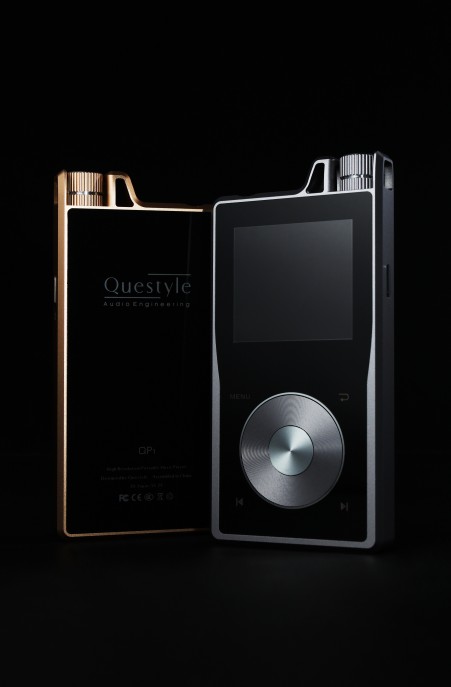
Reply
Reply
Want to join discussion?
Feel free to contribute!